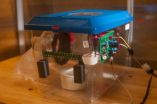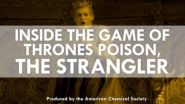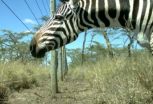(Press-News.org) RIVERSIDE, Calif. (http://www.ucr.edu) — University of California, Riverside researchers have created a method that can classify different species of insects with up to 99 percent accuracy, a development that could help farmers protect their crops from insect damage and limit the spread of insect-borne diseases, such as malaria and Dengue fever.
Over the past 60 years, insect classification research has been limited by factors including an overreliance on acoustic sensing devices, a heavy focus on wingbeat frequency and limited data.
The UC Riverside researchers overcame those limitations by building an inexpensive wireless bug sensor that can track many insect flight behavior patterns and generate much larger amounts of data that can then be incorporated into classification algorithms.
In about three years, by having dozens of sensors running in parallel 24 hours a day, the UC Riverside researchers have collected tens of millions of data points, more than all previous work in this field combined.
"We set out not knowing what was possible," said Eamonn Keogh, a computer science professor at UC Riverside's Bourns College of Engineering. "Now, the problem is essentially solved. We have created insect classification tools that can outperform the world's top entomologists in a fraction of the time."
The research findings are under review for publication in an upcoming issue of the Journal of Insect Behavior. Keogh's co-authors are: Yanping Chen, a computer science graduate student at UC Riverside (the lead author); Adena Why, an entomology graduate student at UC Riverside; Gustavo Batista, of the University of Sao Paulo in Brazil; and Agenor Mafra-Neto, of ISCA Technologies in Riverside.
Filled with tables, chairs and computers, Keogh's lab at the University of California, Riverside Bourns College of Engineering looks like many computer science labs.
But, open the closet door and there are a couple dozen shoebox-size plastic containers from a local pet store, each filled with up to 100 insects and connected to an optical sensor. The sensor consists of a phototransistor array, which is connected to an electronic board and a laser pointing at the phototransistor array.
When the insect passes across the laser beam, its wings partially block the light, causing a small light fluctuation. The fluctuations are captured by the phototransistor array as changes in current, the signal is then filtered and amplified by the custom designed electronic board. The output of the electronic board is fed into a digital sound recorder and recorded as an MP3 and downloaded to a computer.
The goal is to make this automated classification method as simple, inexpensive and ubiquitous as current methods such as sticky traps and interception traps, but with digital advantages such as higher accuracy, real-time monitoring and the ability to collect additional flight behavior patterns.
In their experiments, the UC Riverside researchers worked with six species of insects. As they added additional insect flight behavior patterns to their classification algorithm, they were able to increase their success classifying the different species.
For example, using only wingbeat sounds they had an 88 percent success rate. When they added time of day the success rate jumped to 95 percent. Then, after adding location, the success rate increased to 97 percent.
The researchers believe that success rate can further be improved by adding additional variables, such as height at which the insects fly and environmental variables such as temperature and humidity.
In a separate experiment, the researchers tested classification accuracy by adding an increasing number of species. With two species, they had 99 percent accuracy. That percentage slowly declined as they added more species. For example, with five species they had a 96 percent accuracy rate and with 10 species it was 79 percent.
For hundreds of years humans have attempted to kill unwanted insects. While some blanket methods have been successful, they can be costly and create environmental problems. The sensor developed by UC Riverside researchers aims to change that by counting and classifying the insects so that the substance used to eradicate the harmful insects can be applied on a precision targeted level.
Keogh – who originally developed the sensor with Legos, a 99-cent store laser pointer and a piece from a television remote control – believes the sensors can be built for less than $10 and be powered by solar power or a battery that lasts a year.
In the next year, Keogh, who grew up in Ireland and worked painting carousel horses while attending college in the United States, plans to focus on deploying the sensors around the worldwide. Currently, they are being used on a small scale in Brazil and Hawaii.
Keogh is working with a Tovi Lehmann, an entomologist with the Laboratory of Malaria and Vector Research at the National Institute of Allergy and Infectious Diseases in Rockville, Md., to deploy them in Mali.
INFORMATION:
The research was supported by the Vodafone Americas Foundation, the Bill and Melinda Gates Foundation and São Paulo Research Foundation (FAPESP).
Saving crops and people with bug sensors
Inexpensive wireless sensors with 99 percent accuracy expected to have applications fighting insect-borne dieseases, such as malaria, and insects that damage crops
2014-04-29
ELSE PRESS RELEASES FROM THIS DATE:
The Strangler: The chemistry behind the Game of Thrones poison (video)
2014-04-29
WASHINGTON, April 28, 2014 — Game of Thrones gave us a shock with the Purple Wedding and now everyone is asking: "Who poisoned King Joffrey?" While the search for the killer continues, the American Chemical Society's latest Reactions video focuses on what killed the hated king. The video is available at http://youtu.be/6UNEpRXcxM4
Chemist Raychelle Burks, Ph.D., of Doane College helps us narrow down the suspects in her charismatic style, blending pop culture and chemistry. "Sometimes science gets a bad rap. People think it's dry or super serious," Burks says. "Pop culture ...
Information technology can simplify weight-loss efforts; social support still important for success
2014-04-29
COLUMBIA, Mo. – According to the Centers for Disease Control and Prevention (CDC), 69 percent of adults in the United States are currently overweight or obese, which puts these individuals at increased risk for chronic health problems. Although weight loss decreases this risk, statistics show that dieters often fail multiple times before meeting their goals. Now, MU researchers have found that information technology, such as smartphone applications, can help dieters integrate healthy behavior changes into their daily lives.
"Current weight loss recommendations are essentially ...
Immunogenic mutations in tumor genomes correlate with increased patient survival
2014-04-29
April 29, 2014 – Developing immunotherapies for cancer is challenging because of significant variability among tumors and diversity in human immune types. In a study published online today in Genome Research, researchers examined the largest collection of tumor samples to date to predict patient-specific tumor mutations that may activate the patient's immune system, paving the way for more successful, personalized cancer immunotherapy.
Tumor cells accrue mutations in their DNA, and as these mutations accumulate, the cell looks less and less like part of the body and more ...
Vitamin D may raise survival rates among cancer patients
2014-04-29
Washington, DC—Cancer patients who have higher levels of vitamin D when they are diagnosed tend to have better survival rates and remain in remission longer than patients who are vitamin D-deficient, according to a new study published in the Endocrine Society's Journal of Clinical Endocrinology & Metabolism (JCEM).
The body naturally produces vitamin D after exposure to sunlight and absorbs it from certain foods. In addition to helping the body absorb the calcium and phosphorus needed for healthy bones, vitamin D affects a variety of biological processes by binding to ...
Study: WHO tool underestimates need for osteoporosis treatment
2014-04-29
Washington, DC—The World Health Organization's tool for assessing bone fracture risk underestimates the true dangers for people who are younger than 65 or have been treated for a single broken bone, according to a new study published in the Endocrine Society's Journal of Clinical Endocrinology & Metabolism (JCEM).
A WHO task force developed the Fracture Risk Assessment Tool (FRAX) to help predict the likelihood of adults between the ages of 40 and 90 breaking a bone. FRAX is designed to evaluate the chances that a person will break a bone in a minor fall, which is called ...
Declines in large wildlife lead to increases in disease risk
2014-04-29
In the Middle Ages, fleas carried by rats were responsible for spreading the Black Plague. Today in East Africa, they remain important vectors of plague and many other diseases, including Bartonellosis, a potentially dangerous human pathogen.
Research by Hillary Young, assistant professor in UC Santa Barbara's Department of Ecology, Evolution and Marine Biology, directly links large wildlife decline to an increased risk of human disease via changes in rodent populations. The findings appear today in the Proceedings of the National Academy of Sciences Early Online Edition.
With ...
Chronic stress heightens vulnerability to diet-related metabolic risk
2014-04-29
New research out of UC San Francisco is the first to demonstrate that highly stressed people who eat a lot of high-fat, high-sugar food are more prone to health risks than low-stress people who eat the same amount of unhealthy food.
"Chronic stress can play an important role in influencing biology, and it's critical to understand the exact pathways through which it works." said Kirstin Aschbacher, PhD, an assistant professor in the UCSF Department of Psychiatry and lead author. "Many people think a calorie is a calorie, but this study suggests that two women who eat the ...
GWAS study ties ABCC9 anomalies, sulfonylurea exposure to HS-Aging
2014-04-29
LEXINGTON, Ky. (April 29, 2014) -- A genome-wide association study (GWAS) led by Peter Nelson, MD, PhD, of the Sanders-Brown Center on Aging at the University of Kentucky, and David Fardo, PhD, of UK's Department of Biostatistics, has provided new insight into Hippocampal Sclerosis of Aging (HS-A), a common disease affecting the elderly.
Researchers from 16 different institutions compared 363 persons with autopsy-proven HS-A to a control group of 2,303 other individuals in an attempt to identify genetic predisposition to HS-Aging.
Dr. Nelson and his team found that ...
Carnegie Mellon-Disney researcher invents 3-D printing technique for making cuddly stuff
2014-04-29
PITTSBURGH—Soft and cuddly aren't words used to describe the plastic or metal things typically produced by today's 3D printers. But a new type of printer developed by Carnegie Mellon University and Disney Research Pittsburgh can turn wool and wool blend yarns into fabric objects that people might actually enjoy touching.
The device looks something like a cross between a 3D printer and a sewing machine and produces 3D objects made of a form of loose felt. Scott Hudson, a professor in CMU's Human-Computer Interaction Institute who developed the felting printer with Disney ...
Beyond graphene: Controlling properties of 2-D materials
2014-04-29
The isolation of graphene at the University in 2004 led to the discovery of many other 2D crystals. While graphene has an unrivalled set of superlatives, these crystals cover a large range of properties: from the most conductive to isolating, from transparent to optically active.
The next step is to combine several of these crystals in a 3D stack. This way, one can create 'heterostructures' with novel functionalities – capable of delivering applications as yet beyond the imagination of scientists and commercial partners.
The first examples of such heterostructures already ...
LAST 30 PRESS RELEASES:
How talking slows eye movements behind the wheel
The Ceramic Society of Japan’s Oxoate Ceramics Research Association launches new international book project
Heart-brain connection: international study reveals the role of the vagus nerve in keeping the heart young
Researchers identify Rb1 as a predictive biomarker for a new therapeutic strategy in some breast cancers
Survey reveals ethical gaps slowing AI adoption in pediatric surgery
Stimulant ADHD medications work differently than thought
AI overestimates how smart people are, according to HSE economists
HSE researchers create genome-wide map of quadruplexes
Scientists boost cell "powerhouses" to burn more calories
Automatic label checking: The missing step in making reliable medical AI
Low daily alcohol intake linked to 50% heightened mouth cancer risk in India
American Meteorological Society announces Rick Spinrad as 2026 President-Elect
Biomass-based carbon capture spotlighted in newly released global climate webinar recording
Illuminating invisible nano pollutants: advanced bioimaging tracks the full journey of emerging nanoscale contaminants in living systems
How does age affect recovery from spinal cord injury?
Novel AI tool offers prognosis for patients with head and neck cancer
Fathers’ microplastic exposure tied to their children’s metabolic problems
Research validates laboratory model for studying high-grade serous ovarian cancer
SIR 2026 delivers transformative breakthroughs in minimally invasive medicine to improve patient care
Stem Cell Reports most downloaded papers of 2025 highlight the breadth and impact of stem cell research
Oxford-led study estimates NHS spends around 3% of its primary and secondary care budget on the health impacts of heat and cold in England
A researcher’s long quest leads to a smart composite breakthrough
Urban wild bees act as “microbial sensors” of city health.
New study finds where you live affects recovery after a hip fracture
Forecasting the impact of fully automated vehicle adoption on US road traffic injuries
Alcohol-related hospitalizations from 2016 to 2022
Semaglutide and hospitalizations in patients with obesity and established cardiovascular disease
Researchers ‘listen in’ to embryo-mother interactions during implantation using a culture system replicating the womb lining
How changing your diet could help save the world
How to make AI truly scalable and reliable for real-time traffic assignment?
[Press-News.org] Saving crops and people with bug sensorsInexpensive wireless sensors with 99 percent accuracy expected to have applications fighting insect-borne dieseases, such as malaria, and insects that damage crops




